Cement stands as a cornerstone in the realm of construction materials, playing a pivotal role in the creation of durable and resilient structures. The assurance of its quality is paramount for ensuring the structural integrity and longevity of buildings. To achieve this, construction sites implement a diverse range of testing methods, each meticulously designed to assess specific properties of cement, ensuring it adheres to stringent standards and specifications. This article delves into an in-depth exploration of the key cement testing methodologies routinely conducted on construction sites.
Initial Setting Time Test:
- Cement’s initial setting time: The time it takes for cement paste to change from plastic to rigid.
- Measured by Vicat apparatus: A specialized tool for precise measurement.
- Method: A needle is repeatedly pressed into the paste.
- Endpoint: When the needle leaves no impression, the initial setting time is reached.
Final Setting Time Test:
- Test: Final setting time of cement
- Purpose: Measures when cement reaches full rigidity and hardness
- Tool: Vicat apparatus for precise measurement
- Method: Repeatedly pressing a needle into the paste
- Endpoint: Final setting time reached when the needle no longer penetrates the paste
Compressive Strength Test:
- Test: Compressive strength of cement
- Importance: Measures resistance to compression forces
- Method:
- Prepare cylindrical cement paste specimens
- Cure the specimens
- Apply compressive load in a testing machine
- Record the maximum load at failure
- Result: Compressive strength is calculated based on the maximum load
Soundness Test:
- Test: Soundness of cement
- Purpose: Measures ability to resist volume change after setting
- Method:
- Expose cement specimens to high temperature and pressure in an autoclave
- Measure expansion of specimens
- Interpretation:
- Low expansion indicates good soundness
- High expansion suggests potential problems
Fineness Test:
- Test: Cement fineness
- Importance: Affects how quickly and strongly cement reacts with water (hydration)
- Methods:
- Sieving and residue measurement: Separates particles by size and measures the amount remaining on a specific sieve.
- Blaine air permeability: Measures the total surface area of cement particles.
- Interpretation:
- Finer cement generally has a higher surface area, leading to faster hydration and potentially higher strength.
Consistency Test:
- Test: Flow table test
- Purpose: Measures consistency of cement paste (ease of mixing, placing, and finishing)
- Method:
- Place cement paste on a flow table.
- Raise and drop the table a specific number of times.
- Measure the diameter of the spread paste.
- Interpretation:
- Larger spread diameter indicates higher consistency (easier to work with).
Setting Time Test by Penetration Resistance:
- Setting time measurement: Penetration resistance assessment complements Vicat apparatus.
- Method: Needle attached to a device measures resistance as it penetrates the cement paste.
- Evaluation: Setting time determined by changes in resistance during penetration.
Heat of Hydration Test:
- Test: Heat of hydration
- Importance: Prevents cracking and ensures long-term durability of concrete by managing heat generated during cement setting.
- Method:
- Monitors temperature rise in a calorimeter as cement and water react and harden.
- Interpretation:
- High heat generation indicates potential for cracking.
- Controlled heat release ensures better structural integrity.
Chemical Analysis:
- Purpose: Ensure cement meets industry standards and has desired properties.
- Methods:
- X-ray fluorescence (XRF): Identifies the elemental composition of the cement.
- X-ray diffraction (XRD): Determines the mineralogical phases present in the cement.
- Outcome: Detailed understanding of the cement’s chemical makeup and how it will behave.
In-depth testing of cement on construction sites serves as the linchpin for quality assurance in concrete structures. By leveraging a diverse array of testing methodologies, construction professionals can thoroughly assess various facets of cement, ensuring it not only meets but exceeds the required standards, thereby contributing to the resilience and longevity of the constructed infrastructure.



